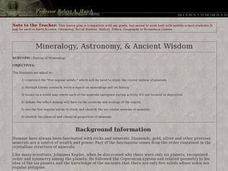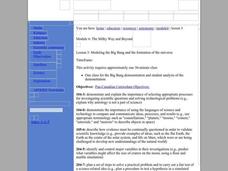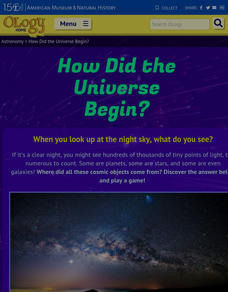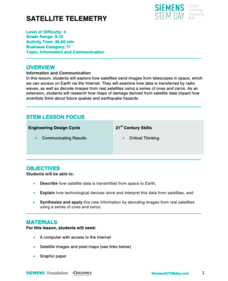Curated OER
Celebrating 100 Years of Flight
Students explore the history, science, and journey through flight. They use the Internet to access information in order to participate in active writing assignments. They conduct other activities and build their own virtual plane.
Curated OER
Planet Picking
Middle schoolers arrange the planets according to their distances from the sun. In this astronomy lesson, students list interesting properties about each planet. They identify an unknown planet photo.
Curated OER
Using Parallax to Determine Distances
Students study parallax and what it is used for. In this distance lesson students complete an activity that allows students to get experience using a parallax.
Curated OER
Mensa For Kids: The Moon
First graders explore space science by completing an arts and crafts activity. In this moon lesson, 1st graders explore the geography of the moon and discuss the importance it has for people living on Earth. Students create a replica...
Curated OER
Hunting for galaxies in the Hubble Deep Field
Learners examine Hubble Deep Field images. In this galaxy classification lesson, students research galaxy classification. Learners view and classify Hubble Deep field images of galaxies.
Curated OER
Tracking and Tracing Sunspots
Learners examine sunspots. In this sunspot lesson, students use applets to investigate the movement of sunspots. Learners research sunspots and evaluate the rotation of the sun. Lesson references outside resources not available in this...
Curated OER
Constellations
Fifth graders create their own constellations using pin holes and black paper. In this space science lesson, 5th graders write a story about their constellation. They share their project with the class.
Curated OER
Black Holes
Students explore what black holes are and how gravity is associated with them. In this space activity students are given enough information to imagine a journey to a black hole.
Curated OER
The Sun: Earth's External Heat Engine Part 1 of the Astronomy Model
Learners become familiar with the variables that control Earth's solar energy supply. They explore the source and nature of solar energy, the genesis of radiation, and the structrue of the Sun, gas spectra are observed and sample...
Curated OER
Astronomy in the Round
In this round astronomical bodies instructional activity, students use 6 photographs of various solar system bodies to answer 5 questions related to the roundness of these bodies. They create a number to represent the roundness of an...
Curated OER
Stormy Sunspots
In this sunspots worksheet, students determine how magnetic storms on Earth are related to sunspot activity. They plot data for sunspot activity between 1967 and 1997. They compare their plotted data with the data for magnetic storms on...
Curated OER
How Hot is that Star?: Astronomy, Sun, Solar Temperature, Science
Students explain sun facts and solar information. They discover how temperature of a star is measured. They investigate the various scales used to measure temperature. They observe images of the sun. They classify stars according to te
Curated OER
Astronomy with a Stick
Students describe the movement of the Earth as it relates to the sun and
formulate a hypothesis for the movement and the changing length of the shadow. They express the relationship between the sun and the Earth and how that causes the...
Curated OER
Mineralogy, Astronomy, & Ancient Wisdom
Students complete a variety of activities surrounding minerals, crystals, and mineralogy. They locate common minerals on a world map, complete a lab in which they identify the chemical and physical properties of various minerals, etc.
Curated OER
The 'Solar' System Past and Present
Students identify cardinal and intermediate directions, recognize that models changes due to new or improved observations and technology, identify the major characteristics of the planets including their positions in the solar system,...
Curated OER
Science: Planet Sizes
Students compare planet sizes using class members holding fruit to represent the planets. They arrange the nine students in planetary order and compare and contrast the planets. Working in groups, students color and decorate planet...
Curated OER
Distances to Stars
Students explore the idea of parallax. In this astronomy lesson, students study the distances of stars. They investigate how parallax can be used to determine these distances.
Curated OER
A DISAPPEARING ACT Astronomy: Do Stars Always Shine?
Students observe why stars are not visible during the day with a classroom demonstration using an index card punched with holes.
Curated OER
Stargazing Astronomy: A Ceiling Full of Stars
Students make an observe a planetarium using a can with nail holes, black paper and a flashlight.
Curated OER
The Big Bang Theory
Students will use scientific reasoning to formulate ideas about the formation of the universe using the Big Bang Theory. The use of critical thinking skills is part of the activity and the foundation of the scientific method will serve...
American Museum of Natural History
How Did the Universe Begin?
The Big Bang Theory is more than a television show. Pupils read how Edwin Hubble observed other galaxies and noticed that the galaxies are moving away from each other. Scholars learn about the idea of the big bang and what happened next...
Space Awareness
Model of a Black Hole
Even light cannot leave the force of a black hole! Learners use a model to explore the gravitational force of a black hole. An elastic bandage and heavy ball serve to create the hole, while marbles become the victims of its strong force.
Space Awareness
The Climate in Numbers and Graphs
Weather versus climate: weather relates to short time periods while climate averages the weather of a period of many years. Scholars learn about average temperature and precipitation in various climate zones and then apply statistics...
Discovery Education
Satellite Telemetry
Satellites require rockets to launch, but it doesn't take a rocket scientist to understand them. Future engineers learn about how satellites send data to Earth and how to interpret satellite images. They see how radio waves play a role...

























